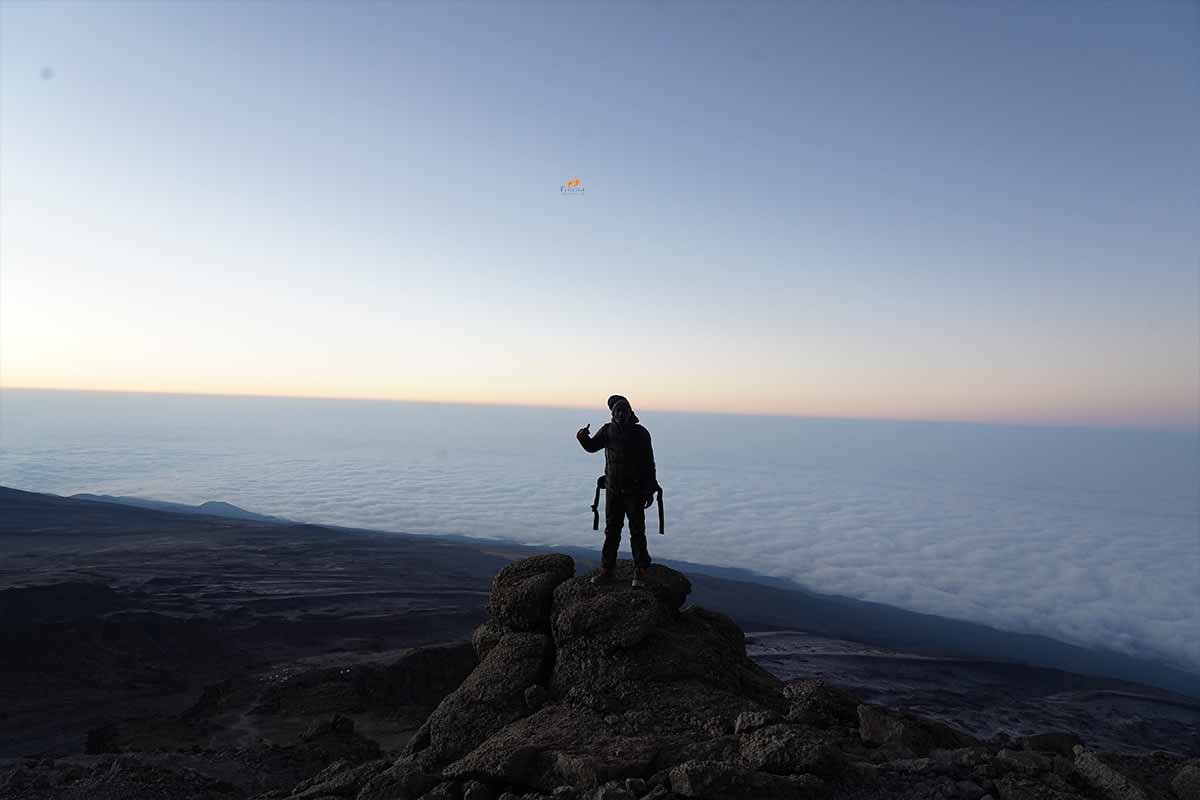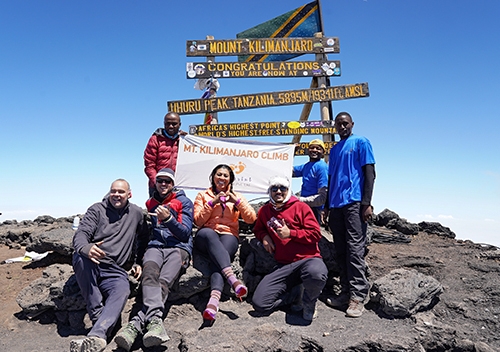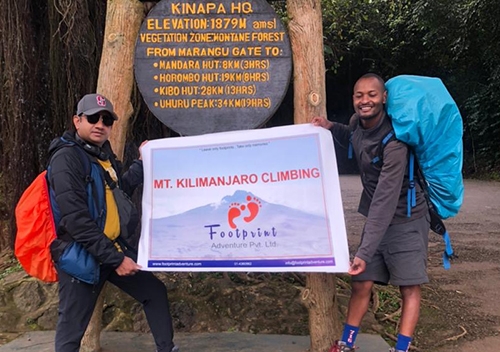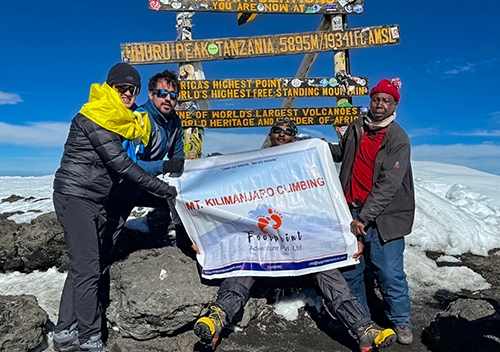
What Is the Kilimanjaro Success Rate?
It is the number of people who make it to the summit. The Kilimanjaro success rate averages around 65-70% on average, while the remaining 30-35% turn back due to altitude sickness, fatigue, or poor preparation. The success rate seems high, but the challenges on the mountain are immense, including altitude, weather, and physical endurance. Success rates on Kilimanjaro vary depending on the route, physical condition, and acclimatization; generally, the longer and gradual the ascent, the better the success rate. Proper preparation is key to improving your chances of summiting. For proper preparation plan, click here.
Why the Success Rate Varies during Kilimanjaro Climb?
1. Climbing Route:
Achieving a summit of Kilimanjaro depends on the selected route type. There are two main routes that people use to climb Kilimanjaro:
the Machame together with Lemosho routes stand out with their higher success rates when compared with the faster Marangu trek.
2. Trek Duration:
Generally, longer hikes correlate with tremendous success, particularly those that include additional acclimatization days.
3. Altitude Sickness and Physical Fitness:
The factor of altitude sickness is the greatest in climbing. Acclimatization and the ability to recognize signs of altitude sickness significantly affect success rates in Kilimanjaro.
4. Preparation and Support:
With proper preparation along with experienced guide and porter support climbers will significantly enhance their opportunity to reach summit. Individuals who both dedicate sufficient time to prepare their Kilimanjaro trek and hire expert guides and porters end up as part of the successful climbing group.
How to Choose the Best Route for Kilimanjaro Success Rate
Choosing the correct route is a crucial decision that can significantly impact the success of your trek. Understanding the success rate of Kilimanjaro by route can empower you to make an informed choice. Here's a breakdown of the success rate on Kilimanjaro by route:
This route, known for its scenic beauty, has a success rate of about 85%. This is due to its longer duration and better acclimatization profile, which gives the trekkers a higher chance of summiting.
This route has an incredibly gentle slope and, therefore, the highest success rate, about 90%. It provides the best acclimatization and allows for stunning views along the route.
Learn more on Kilimanjaro Lemosho route guidebook and Kilimanjaro Lemosho route map
The Marangu Route, often called the "Coca-Cola Route, " has a 60-65% success rate. While this route is shorter and more direct, its quick ascent lowers the success rate due to the increased possibility of altitude sickness.
4. Rongai Route:
The route comes up from the northern side and boasts a 70-75% success rate. It is a much more remote track, so there is less going on than what Marangu might present.
What are the Factors Affecting Kilimanjaro Success Rate
1. Acclimatization
Acclimating to the altitude is the most crucial factor in your Kilimanjaro success rate. If you ascend too quickly, altitude sickness can set in, preventing you from reaching the summit. Go slowly and steadily, and take rest days to help your body adjust.
2. Physical Fitness
Though the climb does not require an elite athlete, you need an excellent fitness level, guaranteeing an increased success rate upon climbing Kilimanjaro. Proper cardiovascular training and strength-building exercises will give you a sufficient boost in meeting the physical needs of the climb, especially the longer routes.
3. Climbing Experience
It will also give you confidence and an enormous success rate in Kilimanjaro. Yet again, numerous climbers with little experience have reached the summit, provided they are physically prepared and mentally resilient. Mental preparation is equally important, as the climb can be mentally challenging, especially during the final push to the summit.
4. Guides and Support Teams
An experienced guide and a good crew can significantly impact your chances of success with the Kilimanjaro Climb. Guides know how to handle the climb and carefully observe all safety conditions, including diagnosing altitude sickness. They can also provide valuable advice on pacing, rest stops, and other aspects of the climb. A good team will make it happen by encouraging, calming, and keeping you on course.
Which is the Best Time to Climb Kilimanjaro: Ideal Seasons for Success
When organizing your climb, choosing the best time of year to hike Kilimanjaro is critical for a safe, comfortable, and memorable experience. The best time to climb Kilimanjaro depends on the weather conditions and personal preferences for crowding, temperature, and visibility.
The Two Main Dry Seasons
The mountain usually has quite unpredictable weather; however, two main dry seasons provide the best conditions for climbing, which include:
January to March:
- Why best time: The months have clear skies, gentle temperatures, and little rain; therefore, they are most liked among periods. Temperatures usually range to a calm environment, though not freezing; thus, the hike would be more comfortable.
- Crowds: There are fewer climbers during this period than during the mid-year dry season, so there will be less congestion on the routes and camps.
- Conditions: Visibility is excellent, and rain does not impede panoramic views or the beauty of the landscape around you.
June to October:
- Why it's the best time: The mid-year dry season is another excellent window for climbing Kilimanjaro. With the rain far behind, temperatures are slightly warmer than in January-March, and the skies remain clear, offering fantastic views of the mountain and the surrounding terrain.
- Crowds: This is the peak season for Kilimanjaro, meaning more climbers. But if you get along with new people and a vibrant atmosphere, this may be an option.
- Conditions: Though warmer, weather is usually stable in these months, with nearly no rain. Higher altitudes can be stressful, but proper acclimatization will help.
The Rainy Seasons: What to Avoid
Climbing during the rainy seasons is not recommended from April to May and November due to several reasons, including:
April to May ( Heavy Rains)
- Why avoid: Heavy rain during this period makes the trails slippery, increases the risk of mudslides, reduces visibility, and is very hazardous for climbers unprepared for such harsh conditions.
- Impact on the climb: Heavy rain makes trekking very difficult, especially on the lower portions of the mountain. Being wet for a long time may also dampen morale.
November (Short Rains):
- Why avoid: While the short rains are less extreme than the long rains, they, too, will impact your trek as they mean wet trails and cloudy skies. The views are poor because of this factor, and the conditions at the summit will also be more severe.
- Impact on Climb: Clouds and occasional showers during the short rains lower the speed and make climbing less pleasurable. The summit can be reached, but weather conditions might make it a bit more complicated.
Choose the right time to climb for a better Kilimanjaro success rate and a safer, enjoyable journey. With preparation and seasonal knowledge, your dream of reaching Kilimanjaro’s summit is attainable.
Tips to Increase Your Kilimanjaro Success Rate

Climbing Mount Kilimanjaro is a once-in-a-lifetime experience, but it requires some preparation if you ever dream of setting foot on its snow-capped peak. The Kilimanjaro success rate depends highly on factors such as acclimatization, physical fitness, and thoughtful planning.
The following tips are essential to increasing your chances of reaching the summit.
1. Allow Time for Good Acclimatization
Gradual Ascent Makes the Difference
Acclimatization stands as the main requirement for reaching the summit point on Kilimanjaro successfully. Body adaptation to high altitude becomes better when your climbing duration increases. Seasoned climbers agree that Lemosho and Machame routes do well for success because they bring gradual elevation that allows proper body adjustment.
2. Hydrate and Maintain Your Nutrition Level
Stay Hydrated and Nourished
Exhaustion can raise the risk of altitude sickness. Drink plenty of water and consume enough calories to sustain energy while ascending. Proper hydration enhances your chances of summiting successfully.
3. Train in Advance
Prepare Your Body for the Challenge
Climbing Kilimanjaro does not need specialized skills since physical conditioning stands as the essential requirement. Your chances of a successful climb will increase substantially through training that includes hiking at elevated altitudes together with cardiovascular exercises and strength exercises.
4. Choose the Right Time to Climb
Timing Your Ascent for Optimal Conditions
The best times to climb Kilimanjaro are during the dry seasons: January to March and June to October. The weather is generally good; low rain prospects increase your success rate.
5. Listen to Your Body
Know When to Stop and Descend
Altitude sickness can occur quickly. Always heed your body’s signals; if you feel unwell, inform your guide immediately. If needed, descending can prevent serious issues and boost your success on Kilimanjaro.
6. Engage Expert Guides
Having a professional guide would make a difference in your success rate. The guides ensure you follow the best routes, take acclimatization, and keep you out of danger.
7. Don't Rush: Follow the "Pole Pole" Rule
The "Pole Pole" rule is the essential rule for acclimatization: slowly, slowly. Climbing too fast increases your chances of altitude sickness and lowers your Kilimanjaro success rate.
8. Eat high-energy foods.
Snacks such as delicious nuts, fresh fruits, and tasty energy bars are great for keeping your energy up throughout the day!
9. Keep Warm
Even in the warmest month, temperatures above Kilimanjaro can fall below freezing. Therefore, your luggage should include cold-weather clothing and extra warm layers for the summit.
The mentioned guidelines will enable you to increase your chances of Kilimanjaro success rate. Proper acclimatization combined with fitness level and hydrating yourself while planning your move ahead will help you succeed on this journey. Both the mountain experiences and the final summit completion should be regarded as equally worthwhile achievements. Each move forward should be experienced with patience toward your complete elevation success.
Kilimanjaro Success Rate: Gear Checklist for a Successful Summit
Climbing Mount Kilimanjaro requires careful planning, and having the right gear will make this a successful trek. Here is a comprehensive gear checklist to ensure you are fully prepared for every aspect of the climb, from base to summit.
We've organized essential equipment to ensure everything is covered:
1. Clothing: Layering for All Conditions
The weather in Kilimanjaro can be highly variable, so you should prepare for everything. Layering clothes is the most effective way to stay comfortable during the ascent.
- Lightweight, moisture-wicking shirts and pants to keep you dry
- Warm layers for summit night: down jacket, thermal base layers
- Waterproof jacket and pants to protect against rain and snow
- Hat, gloves, and scarf for the cold at higher altitudes
Recommendation Read: Beginners Guide To Climb Kilimanjaro
2. Footwear: Comfortable and Supportive
Your footwear will be your key asset during this climb, so carefully choose.
- Sturdy hiking boots with good ankle support (try them before your climb to ensure comfort)
- Gaiters to protect against snow and muddy sections of the trail
- Comfortable camp shoes (flip-flops or lightweight sneakers) to wear during downtime at camps
3. Technical Gear: Essential Tools for Safety and Convenience
Having the appropriate technical equipment guarantees your safety and readiness during the climb.
- Trekking poles to assist with balance and relieve pressure on your knees
- Headlamp with extra batteries for early morning or late-night starts
- Sunglasses to protect your eyes from the bright sun, especially at higher altitudes
- Water bottles or a hydration system (ensure you have enough capacity for your daily water intake)
4. Hydration and Nutrition: Staying Energized
Staying hydrated and nourished is essential for sustaining your energy levels all day.
- Electrolyte tablets to replenish lost salts and minerals during your trek
- High-energy snacks such as energy bars, nuts, and dried fruits to keep you fueled throughout the day
- Water purifying tablets if you prefer not to rely solely on bottled water
5. First Aid and Personal Items: Be Prepared for Emergencies
Ensure you're prepared to manage minor injuries or personal needs while trekking.
- Personal medications (if applicable) and a small first-aid kit
- Camera (optional, but highly recommended) to capture the unforgettable moments of your journey
- Hand sanitizer and wet wipes for hygiene on the trail
The gear checklist ensures you're prepared for Kilimanjaro's challenges. You can enjoy the adventure without worrying about your gear with the right equipment. Check off everything on this list to feel confident in your summit preparation!
Final Thoughts: Your Path to Kilimanjaro Success
Your route selection, physical fitness level, and achieved acclimatization level will affect your success rate on Kilimanjaro. This is a challenging climb, though with good preparation, one's possibilities of summiting increase substantially. You will successfully reach the top of Mount Kilimanjaro by route selection, good training, and guidance from a pro.
At Footprint Adventure, we provide you with the required expertise and assistance for a successful and safe trek. Our guide team at this company will lead you with a commitment to making it an unforgettable event in Kilimanjaro.
Ready to start your adventure? Reach out to Footprint Adventure today, and let us guide you to the top of Mount Kilimanjaro with the best possible chance of success. Your journey to the summit begins now!
FAQs
Where Is Kilimanjaro Located?
Kilimanjaro is found in Tanzania, East Africa. It is the highest peak on the continent, with an altitude of 5,895 meters (19,341 feet) as per its top, Uhuru Peak. Its unique ecosystems and great views make it one of the most popular climbing destinations.
Which Kilimanjaro Route Has the Highest Success Rate?
The Lemosho Route boasts the highest Kilimanjaro success rate, at about 85-90% of the climbers who reach the summit. The reason it's so popular is that it features a more gradual ascent, which allows for better acclimatization, a determinant of avoiding altitude sickness, and, ultimately, a high success rate.
Which Country Is the Kilimanjaro Trek In?
This Kilimanjaro trek is in Tanzania, beginning at one of the many varied gateways to Moshi or Arusha. It will cross the different topographies of rainforests, alpine deserts, and glaciers.
Why Is Kilimanjaro Famous?
It is the highest peak in Africa and one of the Seven Summits, or the highest mountains on each continent. Its iconic status as a nontechnical mountain- one that anyone with proper preparation can attempt to summit- makes it a popular destination for climbers worldwide. Unique ecosystems and stunning views from the summit add to its fame.
What Is the Survival Rate of Kilimanjaro?
Success rates on Kilimanjaro are high, as most trekkers complete the climb if precautions are taken. However, the accepted success rate is around 65-70% because many climbers descend due to altitude sickness or exhaustion. Proper acclimatization and good physical condition significantly increase one's chances of success.
Why Do Climbers Fail to Summit Kilimanjaro?
Climbers fail to summit Kilimanjaro due to altitude sickness, lack of preparation, poor acclimatization, route choice, or physical fatigue. Training and acclimatization are needed to increase one's chances.
Can Anybody Go Up Mount Kilimanjaro?
Even though Mount Kilimanjaro is a non-technical mountain, the trek is tiring. Most climbers can reach the summit with adequate training, fitness, and equipment. It is best to stay healthy and practice physical and mental preparation.
What Is the Best Time to Climb Kilimanjaro?
The best time to climb Kilimanjaro is from January until March and between June and October. During this period, the weather is more straightforward and stable, offering better opportunities to reach the summit.
How Can I Improve My Chances of Summiting Kilimanjaro?
To increase your chances of summiting, take a route with good acclimatization, be in the best physical shape possible, stay hydrated, and listen to expert advice from guides. The better you are prepared, the higher your Kilimanjaro success rate will be.







